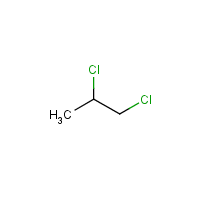Propylene dichloride
Agent Name
Propylene dichloride
Alternative Name
1,2-Dichloropropane
CAS Number
78-87-5
Formula
C3-H6-Cl2
Major Category
Solvents

Synonyms
1,2-Dichloropropane; Bichlorure de propylene [French]; Dichloro-1,2 propane [ISO-French]; Dwuchloropropan [Polish]; alpha,beta-Dichloropropane; alpha,beta-Propylene dichloride; [ChemIDplus] UN1279
Category
Chlorinated Aliphatics
Description
Colorless liquid with a chloroform-like odor. [pesticide]; [NIOSH]
Sources/Uses
Propylene dichloride is used as a solvent for many different purposes. [ACGIH] Used as a solvent in plastics, resins, fats & oils, metal degreasing, rubber processing, and dry cleaning; Used in past as a soil fumigant; [HSDB] "Production of 1,2-dichloropropane in the USA decreased in the early 1980s since it was no longer used in paint strippers, furniture finishes, or as an insecticide." [IARC]
Comments
Acute inhalation studies of rats: respiratory injury, anesthesia and hepatic necrosis; In occupational exposure, the liver and kidneys are the target organs. A dermal sensitizer; [ACGIH] In high-dose reproductive studies of male rats, 1,2-dichloropropane causes testicular damage. [Frazier, p. 248-9] Propylene dichloride is in the list of "Some volatile substances which may be abused by inhalation" published on the web site of the U.N. International Drug Control Programme, indicating its potential to cause narcosis in workers. [Reference #1] A skin, eye, and respiratory tract irritant; Inhalation of high concentrations can cause CNS depression; May cause kidney and liver injury; [ICSC] "There is sufficient evidence in humans for the carcinogenicity of 1,2-dichloropropane. 1,2-Dichloropropane causes cancer of the biliary tract (confirmed as cholangiocarcinoma). . . . However, a minority of the Working Group concluded that the association between 1,2-dichloropropane and cancer of the biliary tract was credible, but the role of exposure to other agents, principally dichloromethane, could not be separated with complete confidence, and noted that most of the evidence came from studies in a single plant." [IARC 2016]
Restricted
No longer available for agricultural use (insecticide and soil fumigant) and no longer available to consumers in paint strippers, varnish, and furniture finish; [ACGIH]
Reference Link #1
Biomedical References
Exposure Assessment
Skin Designation (ACGIH)
No
TLV (ACGIH)
10 ppm
PEL (OSHA)
75 ppm
IDLH (NIOSH)
400 ppm
Vapor Pressure
53.3 mm Hg
Odor Threshold Low
0.26 ppm
Odor Threshold High
0.52 ppm
Lethal Concentration
LC50 (rat) = 3000 ppm/8H
Explanatory Notes
Detection odor threshold from AIHA (mean = 0.26 ppm); Flash point = 16 deg C; VP from HSDB;
Reference Link #2
NFPA
may ignite at ambient temp
Adverse Effects
Skin Sensitizer
Yes
Neurotoxin
Acute solvent syndrome
Hepatotoxin
Occupational hepatotoxin (principal effect)
Nephrotoxin
Yes
Reproductive Toxin
Yes
IARC Carcinogen
Established
ACGIH Carcinogen
Not Classifiable
Diseases, Processes, and Activities Linked to This Agent
Diseases
Occupational diseases associated with exposure to this agent:
Processes
Industrial Processes with risk of exposure: